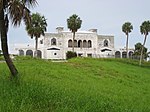Elliott Museum
The Elliott Museum, located at 825 N.E. Ocean Blvd. on Hutchinson Island in Stuart, Florida, United States, focuses on art, history, and technology. Named after the prolific inventor Sterling Elliott, the museum features a changing exhibition gallery and an art studio; maritime, baseball, and local history galleries; and bicycles, classic wooden boats, motorcycles, over 90 cars and trucks, and even an airplane. Over 50 vehicles are displayed in a unique robotic racking system which retrieves vehicles on demand for display on a turntable. The Elliott Museum has one of the largest collections of historic Ford Model A and Model AA commercial vehicles in the world.
Excerpt from the Wikipedia article Elliott Museum (License: CC BY-SA 3.0, Authors).Elliott Museum
Rue Élisée Reclus, Saint-Étienne
Geographical coordinates (GPS) Address Nearby Places Show on map
Geographical coordinates (GPS)
| Latitude | Longitude |
|---|---|
| N 27.2148 ° | E -80.1766 ° |
Address
Condition des soies
Rue Élisée Reclus 14
42000 Saint-Étienne
Auvergne-Rhône-Alpes, France
Open on Google Maps









